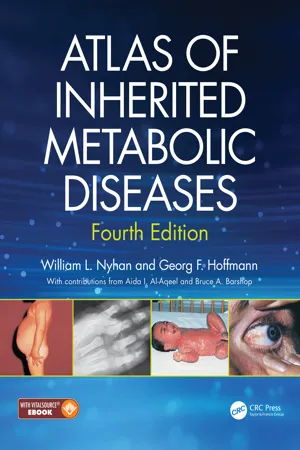
- 856 pages
- English
- ePUB (mobile friendly)
- Available on iOS & Android
Atlas of Inherited Metabolic Diseases
About this book
In a field where even experts may find that years have elapsed since they last encountered a child with a given disorder, it is essential for the clinician to have a comprehensive source of practical and highly illustrated information covering the whole spectrum of metabolic disease to refer to.
The content is divided into sections of related disorders, including disorders of amino acid metabolism, lipid storage disorders, and mitochondrial diseases for ease of reference, with an introductory outline where appropriate summarizing the biochemical features and general management issues. Within the sections, each chapter deals with an individual disease, opening with a useful summary of major phenotypic expression including clear and helpful biochemical pathways, identifying for the reader exactly where the defect occurs.
Throughout the book, plentiful photographs, often showing extremely rare disorders, are an invaluable aid to diagnosis.
Key Features
• Fully updated to incorporate all new developments in the field
• Brand new chapters cover methylmalonic aciduria of ACSF3 deficiency, branched chain keto acid dehydrogenase deficiency, serine deficiencies, purine nucleoside phosphorylase deficiency, antiquitin deficiency, and others
• Excellent and detailed clinical descriptions, with numerous valuable hints and suggestions for management
• Helpful explanatory algorithms and decision trees, and high-quality illustrative material including biochemical pathways and an unrivaled photographic collection, which enhance clinical applicability
The fourth edition of this highly regarded book, authored by two of the foremost authorities in pediatric metabolic medicine, continues to provide incomparable insight into the problems associated with metabolic diseases and remains invaluable to pediatricians, geneticists, and general clinicians worldwide.
Frequently asked questions
- Essential is ideal for learners and professionals who enjoy exploring a wide range of subjects. Access the Essential Library with 800,000+ trusted titles and best-sellers across business, personal growth, and the humanities. Includes unlimited reading time and Standard Read Aloud voice.
- Complete: Perfect for advanced learners and researchers needing full, unrestricted access. Unlock 1.4M+ books across hundreds of subjects, including academic and specialized titles. The Complete Plan also includes advanced features like Premium Read Aloud and Research Assistant.
Please note we cannot support devices running on iOS 13 and Android 7 or earlier. Learn more about using the app.
Information

| Table 1.1 Mnemonic for the differential diagnosis of metabolic acidosis with an elevated anion gap (DIMPLES) | |
| D | Diabetic ketoacidosis |
| I | Inborn error of metabolism, iron, isoniazid |
| M | Methanol, metformin |
| P | Paraldehyde, phenformin |
| L | Lactic acidemia |
| E | Ethanol, ethylene glycol |
| S | Salicylates, solvents, strychnine |
| The mnemonic has been written as “mudpiles” or “mudpies”, including u for uremia, but, in clinical practice, uremia tends to be recognized as early as the acidosis, making this unnecessary; the latter form leaves out lactic acidemia, an important omission. The current form highlights metabolic causes of acidosis. | |
| Table 1.2 Acylcar... |
Table of contents
- Cover
- Half Title
- Title Page
- Copyright Page
- Contents
- Preface by William L. Nyhan
- Preface by Georg F. Hoffmann
- Contributors
- Part 1: Organic acidemias
- Part 2: Disorders of amino acid metabolism
- Part 3: Hyperammonemia and Disorders of the Urea Cycle
- Part 4: Disorders of fatty acid oxidation
- Part 5: The lactic acidemias and mitochondrial disease
- Part 6: Disorders of carbohydrate metabolism
- Part 7: Peroxisomal disorders
- Part 8: Disorders of purine and pyrimidine metabolism
- Part 9: Mucopolysaccharidoses
- Part 10: Mucolipidosis
- Part 11: Disorders of Cholesterol and Neutral Lipid Metabolism
- Part 12: Lipid Storage Disorders
- Part 13: Miscellaneous
- Appendix: Differential diagnosis of clinical phenotypes
- Index